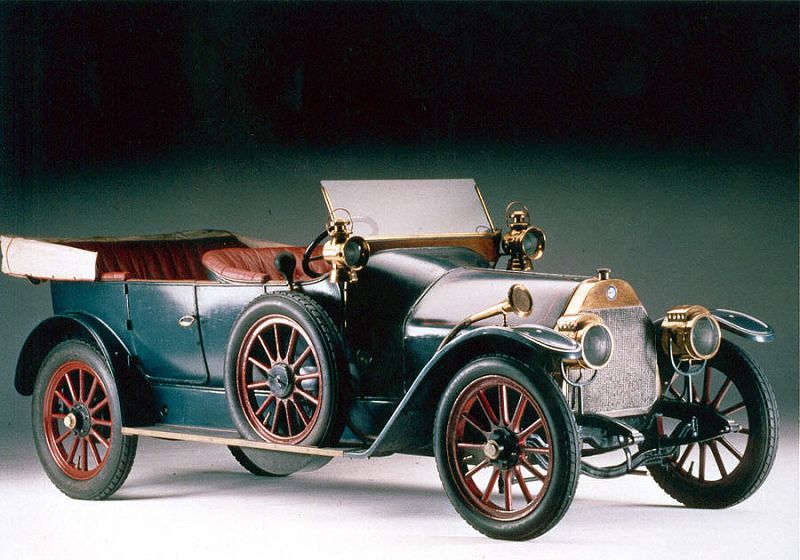Italy’s automotive landscape of 1910 stood at the crossroads of tradition and innovation. Small workshops transformed into industrial powerhouses, marking the dawn of a new era in transportation. The streets of Milan buzzed with the sound of early automobiles, each representing a step toward motorized mobility.
The emergence of A.L.F.A. (Anonima Lombarda Fabbrica Automobili) marked a pivotal moment in this transformation. Their first creation, the 24 HP, wasn’t just another automobile — it represented Italian engineering prowess and laid the foundation for a legacy that would span over a century.
Birth of an Icon
The development of the Alfa 24 HP began in the workshops of Portello, Milan. Engineers worked tirelessly to create something extraordinary — a vehicle that would combine performance with reliability. The 4.1-liter engine represented cutting-edge technology for its time, featuring innovations rarely seen in early 20th-century automobiles.
Early production models quickly caught the attention of automotive enthusiasts and critics alike. Each vehicle underwent rigorous testing before delivery, establishing A.L.F.A.’s reputation for quality.
“The 24 HP stands as a testament to Italian engineering excellence. Its balance of power and refinement sets new standards for automotive design.” — Giuseppe Merosi, Lead Engineer, 1910
Historical Reference!
The naming convention '24 HP' reflected actual horsepower output, though later testing would reveal the engine capable of producing up to 42 horsepower — a significant achievement for its era.
The manufacturing process involved meticulous attention to detail. Each component underwent careful inspection, ensuring the highest quality standards. This dedication to excellence would become a hallmark of the Alfa Romeo brand.
Engineering Excellence
The heart of the 24 HP beat with remarkable innovation. Its inline-four engine delivered impressive performance through a sophisticated valve system. The 4084cc powerplant featured removable cylinder heads — a forward-thinking design choice that simplified maintenance and repairs.
Modern automotive engineering owes much to these early innovations. The engine’s key features included:
- water cooling system with advanced thermal management;
- naturally aspirated intake with optimized airflow;
- precision-engineered connecting rods and crankshaft;
- durable cast iron block construction;
- innovative valve timing mechanism.
Fact!
The 24 HP's engine compression ratio of 4.15:1 might seem modest by today's standards, but it represented optimal engineering for the quality of fuel available in 1910.
Design and Innovation
The 24 HP’s elegant touring body exemplified early 20th-century automotive design. Its proportions balanced aesthetics with functionality, setting standards for future Alfa Romeo vehicles. The spacious interior accommodated four passengers comfortably, while maintaining a sporty profile.
“Examining the 24 HP today reveals timeless design principles that influenced generations of automobiles. Its proportions remain remarkably relevant.” — Marco Tenconi, Classic Car Restoration Expert
Info!
The vehicle's 4250mm length and 1550mm width created an ideal footprint for both city use and long-distance touring — dimensions that would influence automotive design for decades.
The attention to detail extended beyond mere aesthetics. Each body panel served a purpose, from the carefully angled windscreen to the practical storage solutions.
Racing Heritage
The 24 HP quickly proved its mettle on the racing circuit. A.L.F.A. recognized the marketing potential of motorsport success and modified several units for competition. The vehicle’s robust chassis and powerful engine made it a formidable competitor.
Racing versions received enhanced timing systems and lightweight components. These modifications demonstrated the platform’s versatility and engineering excellence.
Important!
The 24 HP's racing success established Alfa Romeo's commitment to motorsport — a tradition that continues to this day.
Competition-spec models achieved impressive results, regularly reaching speeds of 100 km/h — remarkable for the era.
Forging a Legacy
The impact of the Alfa 24 HP extends far beyond its three-year production run. This pioneering vehicle established design and engineering principles that would influence automotive development for decades.
Today, collectors and enthusiasts recognize the 24 HP as more than just Alfa Romeo’s first automobile — it represents the birth of Italian automotive excellence. Its legacy lives on in every Alfa Romeo that follows, each carrying a piece of that original innovative spirit.
Pros & Cons
| Advantages | Disadvantages |
|---|---|
| Revolutionary engine design for its era | Limited production numbers affecting parts availability |
| Exceptional build quality and durability | Higher maintenance complexity compared to contemporaries |
| Innovative removable cylinder head design | Relatively heavy chassis affecting performance |
| Versatile platform suitable for racing modifications | Limited brake technology by modern standards |
| Superior power output compared to contemporary vehicles | Challenging restoration process due to rare components |
The Alfa 24 HP’s strengths far outweigh its limitations, especially considering its pioneering role in automotive history. While modern eyes might focus on its technological constraints, the vehicle’s innovations and build quality established standards that influenced automotive development for generations to come.

